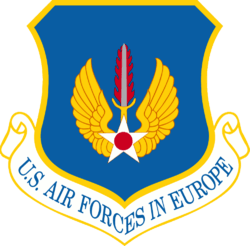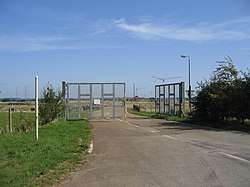RAF Barford St John
Royal Air Force Barford St John or RAF Barford St John is a Royal Air Force station just north of the village of Barford St. John, Oxfordshire, England. It is now a non-flying facility, operated by the United States Air Force as a communications centre with many large communications aerials, and is a satellite of RAF Croughton.
RAF Barford St John | |||||||||||
|---|---|---|---|---|---|---|---|---|---|---|---|
| Part of United States Air Forces in Europe - Air Forces Africa (USAFE-AFAFRICA) | |||||||||||
| Near Bloxham, Oxfordshire in England | |||||||||||
 Gate and communications masts at RAF Barford St John | |||||||||||
 RAF Barford St John Shown within Oxfordshire | |||||||||||
| Coordinates | 52°00′13″N 001°21′36″W | ||||||||||
| Type | Royal Air Force station (US Visiting Forces) | ||||||||||
| Code | BJ | ||||||||||
| Site information | |||||||||||
| Owner | Ministry of Defence | ||||||||||
| Operator | Royal Air Force United States Air Force | ||||||||||
| Controlled by | US Air Forces in Europe - Air Forces Africa | ||||||||||
| Condition | Operational | ||||||||||
| Site history | |||||||||||
| Built | 1941 | ||||||||||
| In use | 1941–1946 (Royal Air Force) 1951 – present (US Air Force) | ||||||||||
| Airfield information | |||||||||||
| Elevation | 120 metres (394 ft) AMSL | ||||||||||
| |||||||||||
| Notes: Flying ceased in 1946. | |||||||||||
History
RAF Barford St John was opened on 30 July 1941 as a training facility for RAF Flying Training Command. It had three grass runways, used primarily by Airspeed Oxfords of No. 15 Service Flying Training School RAF from RAF Kidlington. The airfield was closed in late 1941 and rebuilt as an RAF Bomber Command airfield with paved runways and equipped for night operations.
The airfield reopened in December 1942 as a satellite for RAF Upper Heyford. Bomber Command and No. 16 Operational Training Unit was stationed there with Vickers Wellingtons until December 1944. No. 1655 Mosquito Training Unit RAF replaced the Wellingtons and the unit was renamed No. 16 OTU in January 1945 when it moved to RAF Cottesmore. In 1943 the station served as flight test centre for its Gloster E.28/39 and Gloster Meteor jet aircraft[1] from RAF Brockworth.
After the war the airfield was closed in 1946 and placed into care and maintenance.
The site was used for some background filming for the 1949 film Twelve O'Clock High.
The following units were also here at some point:[2]
- No. 4 Squadron RAF[3]
- No. 21 Heavy Glider Conversion Unit RAF
- No. 169 Squadron RAF[4]
- No. 170 Squadron RAF[5]
USAF use
In 1951[1] the United States Air Force opened a communications (transmitter) centre on the airfield, reporting to the 2130th Communications Group (UK Communications Region) at RAF Croughton.
Given its postwar use by the military, all its runways, perimeter track and hardstands still exist but the World War II buildings have been removed, being replaced by modern buildings on the airfield, secured and guarded with fencing and other security devices.
Simon Duke's U.S. Military Forces and Installations in Europe (SIPRI, 1989) lists the base as housing a Giant Talk/Scope Signal III transmitter annex for RAF Croughton (p.314).
References
Citations
- Crossley, William (20 September 2011). "Base's special place in aviation history". Oxford Mail. Retrieved 26 September 2011.
- "Barford St John". Airfields of Britain Conservation Trust. Retrieved 23 June 2020.
- Jefford 1988, p. 24.
- Jefford 1988, p. 169.
- Jefford 1988, p. 65.
Bibliography
- Jefford, C.G. (1988). RAF Squadrons. A comprehensive record of the movement and equipment of all RAF squadrons and their antecedents since 1912. Shrewsbury: Airlife. ISBN 1-85310-053-6.
